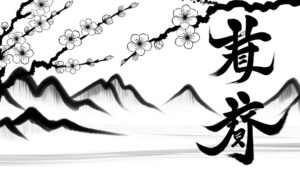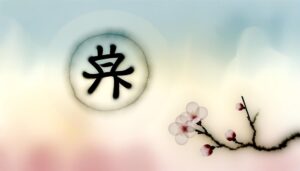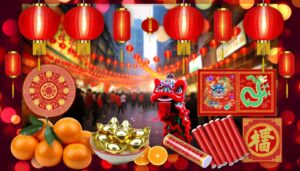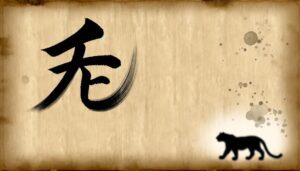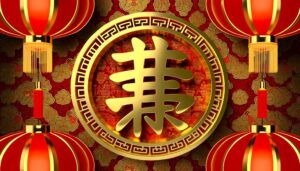Incorporating the Chinese Symbol of Happiness in Home Decor
The Chinese character '福' (Fú) symbolizes happiness and good fortune, representing both material prosperity and divine blessings. Emerging from ancient oracle bones in the Shang Dynasty, it evolved through the Zhou Dynasty's seal script.
Deeply embraced in Confucian and Daoist contexts, '福' underscores auspiciousness and spiritual well-being. Displayed during the Lunar New Year, often upside down, it invites luck into homes.
Rich cultural significance pervades art, festivals, and regional variations, weaving a tapestry of communal joy and prosperity. Explore further to appreciate how this symbol influences not only traditional practices but also modern interpretations and applications.
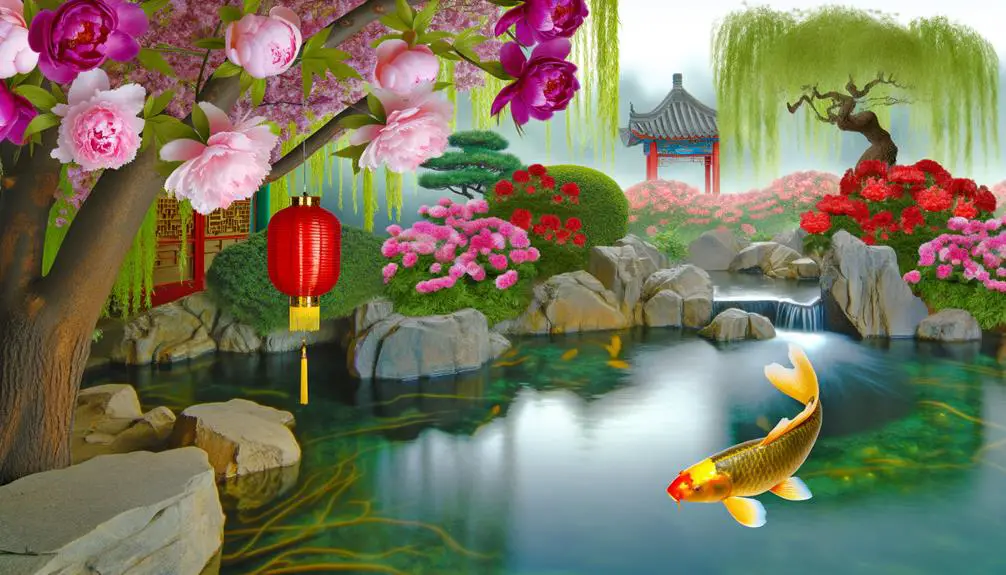
Key Takeaways
- The character '福' (Fú) is the primary symbol of happiness and good fortune in Chinese culture.
- '福' combines divine blessings and material prosperity, emphasizing spiritual well-being.
- Displayed upside down during Lunar New Year to signify happiness arriving.
- Integral to festivals, weddings, and business openings, enhancing auspiciousness.
- Red, symbolizing happiness, is commonly used with '福' for attracting luck.
The Character '福' (Fú)
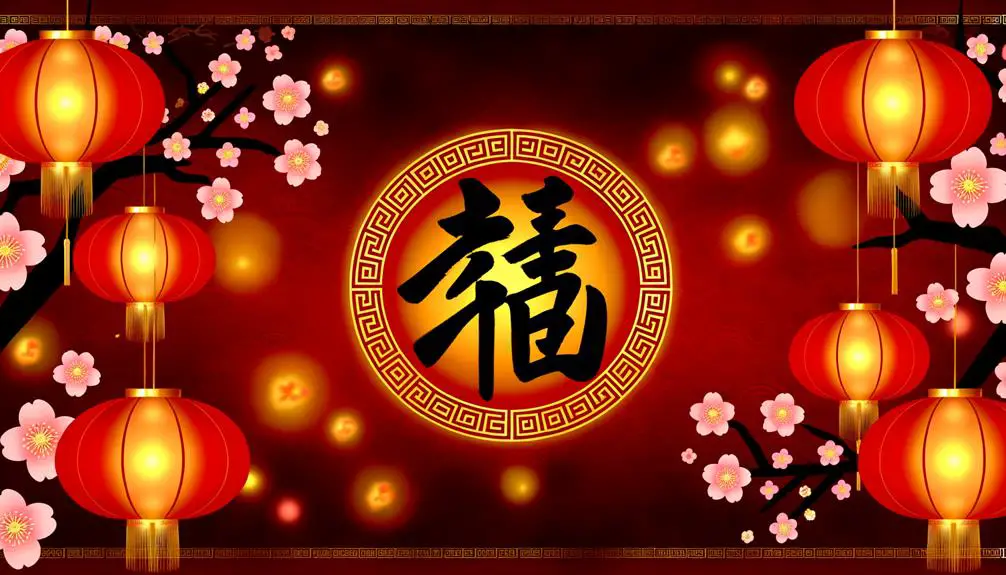
The Chinese character '福' (Fú) epitomizes the concept of happiness and good fortune, deeply embedded in the cultural and historical fabric of Chinese society. This multifaceted character is composed of the radical 礻(shì), symbolizing a deity or spirit, and 畐 (fú), signifying abundance. Together, they encapsulate the idea of divine blessings and material prosperity.
In Chinese culture, 福 transcends its literal meaning, serving as a ubiquitous emblem during festivities, particularly the Lunar New Year. The character is often displayed upside down, a visual pun signifying that fortune has arrived. Its usage underscores the cultural emphasis on auspiciousness, reflecting a broader worldview where spiritual and material well-being are intricately linked.
Historical Origins
Tracing its roots back to ancient Chinese civilization, the character '福' (Fú) has evolved through millennia, reflecting the changing socio-religious paradigms and the enduring human pursuit of happiness and prosperity.
Originally inscribed on oracle bones during the Shang Dynasty (1600-1046 BCE), '福' was associated with sacrificial offerings to deities, signifying divine blessings. As Chinese script progressed from oracle bone to bronze inscriptions, and later to seal script in the Zhou Dynasty (1046-256 BCE), '福' retained its core meaning but expanded to symbolize well-being and fortune.
Confucianism and Daoism further enriched its connotations, embedding '福' deeply into Chinese philosophical and ethical frameworks. This historical evolution underscores '福' as a profound emblem of collective aspirations and values.
Cultural Significance
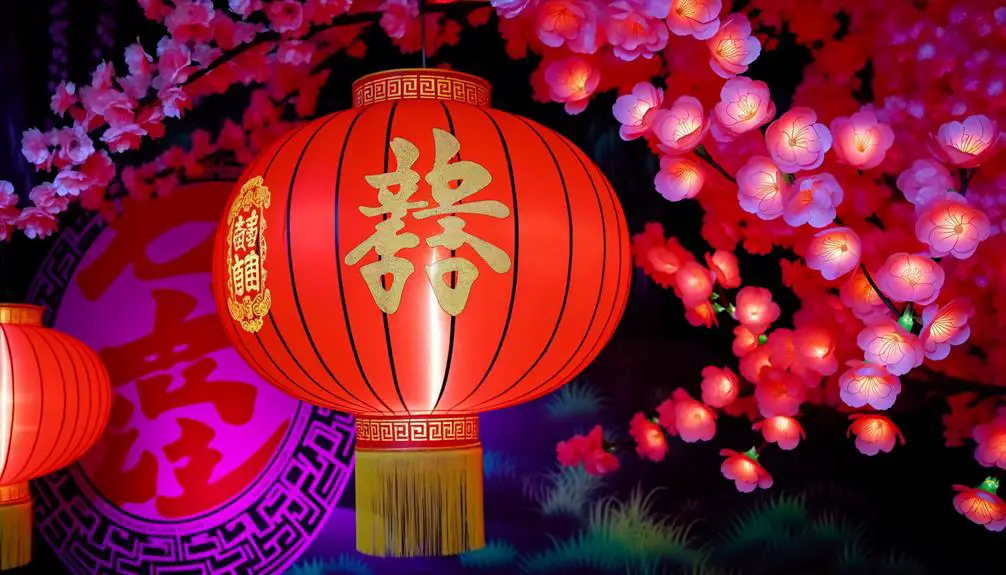
In contemporary Chinese society, the character '福' (Fú) remains a pervasive symbol, intricately woven into the fabric of cultural practices, festivals, and everyday life, embodying aspirations for happiness, good fortune, and prosperity.
Its ubiquity is particularly evident during the Lunar New Year, where inverted 'Fú' characters are prominently displayed to invite fortune. This practice stems from a linguistic pun; the word for 'upside down' sounds like 'arrive,' symbolizing the arrival of happiness.
Additionally, 'Fú' features in wedding ceremonies, business openings, and other significant events, reflecting a deep-seated cultural belief in the power of symbols to influence destiny.
The character's prominence in public and private spaces underscores its role as a cultural cornerstone, reinforcing collective values and aspirations.
Symbolism in Art
In traditional Chinese art, the symbolism of happiness is intricately woven through the use of specific colors and motifs, each carrying deep cultural resonance. Colors such as red and gold frequently represent joy and prosperity, while motifs like the Double Happiness character (囍) and images of mythical creatures symbolize auspiciousness and conjugal bliss.
These artistic elements not only convey emotional states but also provide a visual lexicon that communicates societal values and aspirations.
Colors and Emotions
The interplay between colors and emotions in Chinese art reveals profound cultural symbolism. Specific hues are meticulously chosen to convey complex emotional and philosophical messages. This nuanced use of color is deeply embedded in Chinese traditions, where each shade carries its own significance.
Red symbolizes happiness, prosperity, and good fortune. It is prominently used in festivals and weddings, reflecting joy and celebration.
Black represents water and is linked to stability and depth. It also signifies power and authority, often used in official or formal contexts.
Yellow is associated with the Earth and imperial power. Historically, it was reserved for the emperor, embodying wealth, grandeur, and the center of the universe.
These colors collectively create a rich tapestry of emotional expression in Chinese art.
Traditional Chinese Motifs
Building upon the profound emotional resonance conveyed through color, traditional Chinese motifs further enrich the cultural narrative by embedding deep symbolic meanings within artistic representations.
These motifs, steeped in millennia of cultural heritage, often depict elements such as the dragon, the phoenix, and the lotus flower. The dragon symbolizes power and good fortune, while the phoenix represents rebirth and eternal life. The lotus flower, emerging unstained from muddy waters, signifies purity and spiritual enlightenment.
Such imagery is meticulously crafted into textiles, ceramics, and architecture, serving not only as decoration but also as conveyors of cultural wisdom and values. By integrating these symbols, traditional Chinese art provides insight into the philosophical and moral underpinnings of Chinese society.
Usage in Festivals
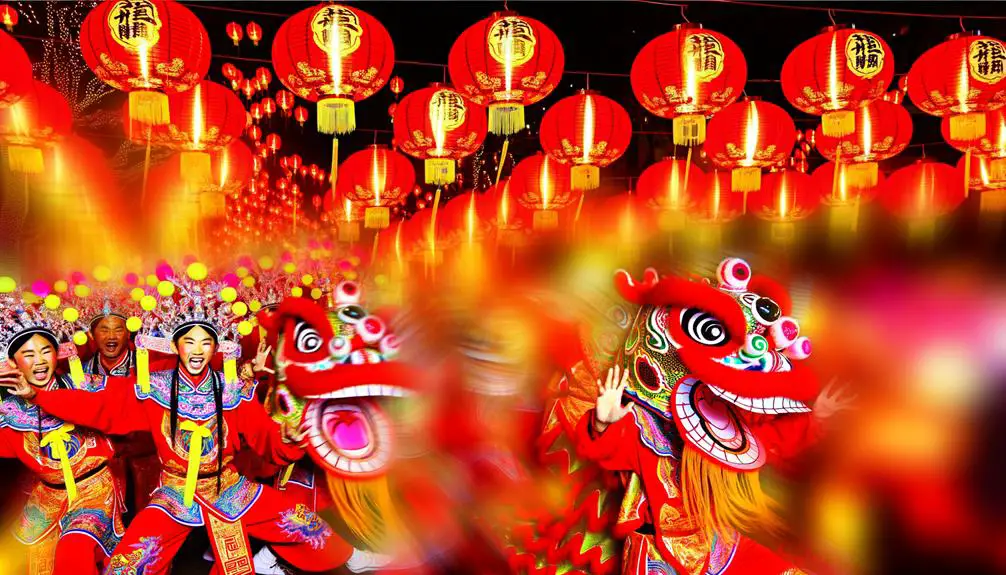
Traditional Chinese festivals prominently feature the symbol of happiness, illustrating its deep-rooted cultural significance and its role in fostering communal joy and prosperity.
During the Lunar New Year, red paper cuttings of the character for happiness (福) are displayed on doors and windows, symbolizing the ushering in of good fortune.
The Mid-Autumn Festival sees families gathering to share mooncakes adorned with happiness symbols, reinforcing familial bonds.
- Lunar New Year: Red happiness symbols are believed to attract luck and ward off misfortune.
- Mid-Autumn Festival: Mooncakes featuring happiness characters signify unity and shared joy.
- Double Ninth Festival: The happiness symbol reflects wishes for longevity and well-being.
These practices underscore the pervasive influence of happiness symbols in cultural rituals and communal celebrations.
Role in Feng Shui
In the practice of Feng Shui, the Chinese symbol for happiness plays a pivotal role in harmonizing home energy by strategically placing it to enhance the flow of positive chi. This symbol is often integrated into home décor and design to attract prosperity and well-being, reflecting its deep-rooted cultural significance.
The application of happiness symbols in Feng Shui underscores a broader philosophy aimed at creating balanced and auspicious living spaces.
Harmonizing Home Energy
Frequently seen as a crucial practice within Feng Shui, the strategic placement of happiness symbols can greatly enhance the harmonious flow of energy, or 'qi,' within a home.
These symbols are believed to act as conduits, attracting positive energy and promoting well-being. Their effectiveness is optimized when positioned in areas that correspond to auspicious sectors of the Bagua map. This ancient Chinese practice emphasizes balance and harmony, aiming to create an environment conducive to happiness and prosperity.
- Symbolic Representation: Each happiness symbol carries unique cultural significance, enriching the home's spiritual atmosphere.
- Energy Flow: Proper placement guarantees the unobstructed movement of 'qi', enhancing overall liveliness.
- Aesthetic Integration: These symbols also contribute to the aesthetic harmony, blending seamlessly with decor.
Enhancing Positive Chi
Enhancing positive chi within the practice of Feng Shui involves a meticulous understanding of spatial dynamics and the strategic placement of objects to foster an environment of balance and energy.
Central to this methodology is the arrangement of furniture, art, and other elements to direct energy flow harmoniously throughout a space.
The 'happiness' symbol, often integrated into Feng Shui practices, serves as a potent conduit for positive chi. Its placement in key areas, such as living rooms or entryways, can amplify the beneficial energies, promoting an atmosphere of joy and well-being.
This practice underscores the importance of intentional design, where each element contributes to a cohesive and energetically balanced environment, enhancing overall harmony and liveliness in the living space.
Attracting Prosperity Symbols
The integration of prosperity symbols within Feng Shui practices is anchored in the belief that these symbols can magnetize wealth, success, and abundance by harnessing and directing positive energy flows. This ancient Chinese art meticulously places objects to optimize 'Chi' or life force energy, thereby fostering prosperity.
Notable symbols include:
- Money Frogs: Placed near entry points to attract financial gains.
- Laughing Buddha: Symbolizes happiness and plenitude, often positioned in living areas to invite joy and wealth.
- Chinese Coins: Tied with red ribbon and placed in wallets or cash registers to secure monetary flow.
Understanding the strategic placement of these symbols provides deeper insights into Feng Shui's role in promoting material and emotional well-being.
Modern Interpretations
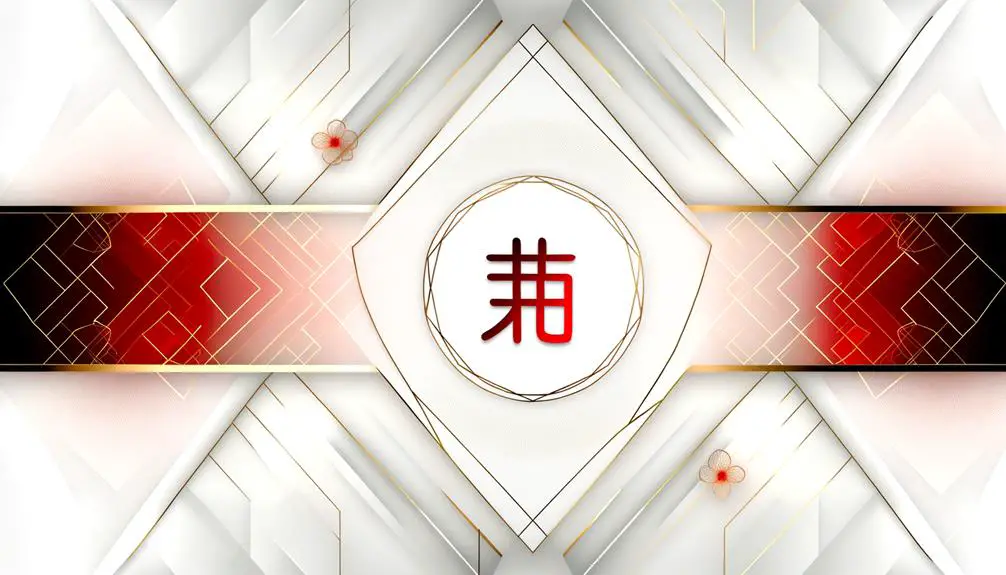
In contemporary Chinese society, the symbol of happiness has evolved to encompass a blend of traditional values and modern aspirations, reflecting the dynamic interplay between cultural heritage and contemporary lifestyles.
Traditionally represented by characters like '福' (fú), symbolizing good fortune, happiness now also incorporates elements such as career success, personal fulfillment, and technological advancement.
This evolution is evident in urban settings where digital expressions of happiness, such as emojis and social media symbols, coexist with age-old practices like hanging red lanterns.
Additionally, the emphasis on education and global connectivity has redefined happiness to include access to opportunities and international experiences.
Hence, modern interpretations of happiness in China demonstrate an adaptive cultural narrative continuously shaped by historical and societal changes.
Regional Variations
Regional variations in the symbol of happiness within China reveal a rich tapestry of localized customs and interpretations, each deeply rooted in the unique historical, geographical, and cultural contexts of different provinces and ethnic groups.
For instance, in southern China, particularly in Guangdong, the character for happiness (喜) is often integrated into elaborate paper cuttings used during festive occasions.
In contrast, the Miao ethnic group in Guizhou employs intricate silver ornamentation to depict happiness symbols, reflecting their metallurgical traditions.
Meanwhile, in northern China, especially in Beijing, the symbol frequently appears in red couplets displayed during the Lunar New Year.
Calligraphy and Design
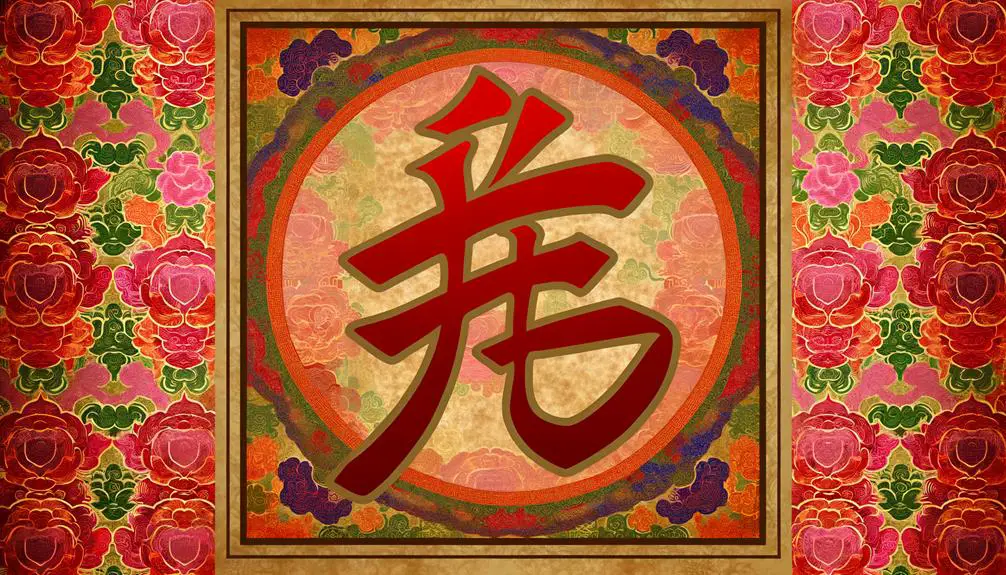
When examining the symbol of happiness in Chinese culture, it is essential to contemplate the traditional brush techniques that have been honed over centuries. These techniques give the character its distinctive elegance and fluidity.
Simultaneously, modern design trends have begun to reinterpret this symbol, incorporating contemporary aesthetics without losing the essence of its historical significance.
This interplay between the traditional and the modern offers a rich tapestry for understanding how the symbol's representation continues to evolve while retaining its cultural roots.
Traditional Brush Techniques
Traditional Chinese brush techniques in calligraphy and design embody a centuries-old art form that intricately combines precision, fluidity, and expressive movement to convey profound cultural symbols, such as happiness. The complexity of these techniques lies in the mastery of brush pressure, angle, and pace, which collectively influence the stroke's texture and emotion.
Each stroke must be deliberate, reflecting the artist's inner state and connection to the cultural ethos.
Brush Pressure: Varying pressure creates different line thicknesses, symbolizing the dynamic nature of happiness.
Brush Angle: Adjusting angles affects the stroke's direction and flow, mirroring the multifaceted aspects of joy.
Brush Speed: Speed variations impart energy and vibrancy to the strokes, embodying the lively essence of happiness.
These elements collectively enhance the symbolic representation of happiness in traditional Chinese calligraphy.
Modern Design Trends
How have contemporary innovations in calligraphy and design redefined the traditional symbolism of happiness in Chinese culture? Modern design trends integrate digital tools and cross-cultural influences, creating a dynamic reinterpretation of the Chinese character for happiness (福, fú). These trends blend traditional brush techniques with minimalist aesthetics, vibrant color palettes, and 3D rendering, thereby broadening the character's resonance in global contexts.
| Traditional Elements | Modern Techniques | Resulting Impact |
|---|---|---|
| Brush Strokes | Digital Calligraphy Tools | Enhanced Precision and Versatility |
| Red and Gold Colors | Diverse Color Palettes | Expanded Symbolic Associations |
| Paper Medium | Virtual Platforms | Increased Accessibility and Appeal |
| Cultural Context | Cross-Cultural Designs | Global Recognition and Adaptability |
Common Misconceptions
Despite its widespread recognition, the symbol of happiness in Chinese culture is often misinterpreted due to variations in regional dialects and historical context. This complexity stems from the multifaceted nature of the character '福' (fú), which can be confused with other characters or cultural symbols.
- Regional Variations: Different Chinese dialects and regions may pronounce or interpret '福' differently, leading to diverse understandings.
- Historical Context: Over centuries, the character has been imbued with varying connotations, influenced by historical events and societal changes.
- Symbolic Confusion: '福' is often mistaken for other auspicious symbols such as '禄' (lù, representing prosperity), and '寿' (shòu, representing longevity), which can dilute its specific meaning of happiness.
Understanding these nuances is essential for accurate interpretation.
How to Incorporate '福
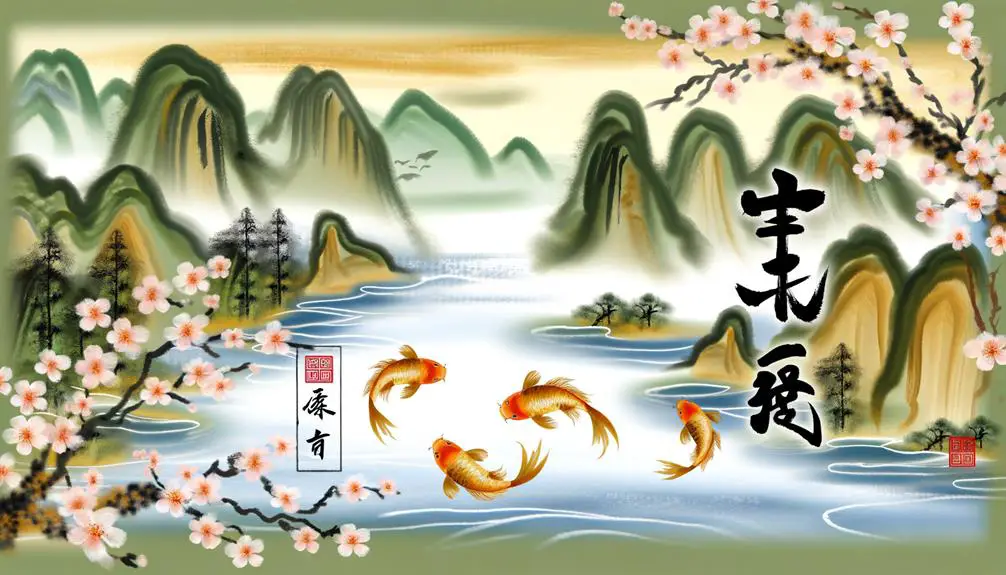
Incorporating the character '福' (fú) into various aspects of life demands a nuanced understanding of its cultural significance and historical applications.
Traditionally, '福' is prominently featured during Chinese New Year, symbolizing the arrival of blessings and prosperity. It is often displayed upside down on doorways, as the pronunciation of 'upside down' (倒, dào) is a homophone for 'arrival' (到, dào).
In interior design, '福' can be integrated into artworks, textiles, and ceramics to perpetuate an ambiance of well-being. Additionally, in corporate settings, '福' is used in branding and office décor to attract success and harmony.
Understanding these historical contexts guarantees that '福' is not merely decorative, but meaningful in fostering positive cultural resonance.
Conclusion
To sum up, the character '福' (Fú) stands as a pervasive emblem of happiness within Chinese culture, embodying profound historical origins and rich cultural significance.
Its diverse representations in art, festivals, and calligraphy are akin to the multifaceted reflections in a prism, each angle revealing a unique aspect of joy and prosperity.
Understanding '福' necessitates a thorough exploration of its regional variations and symbolic meanings, dispelling common misconceptions and highlighting its enduring influence in contemporary society.


